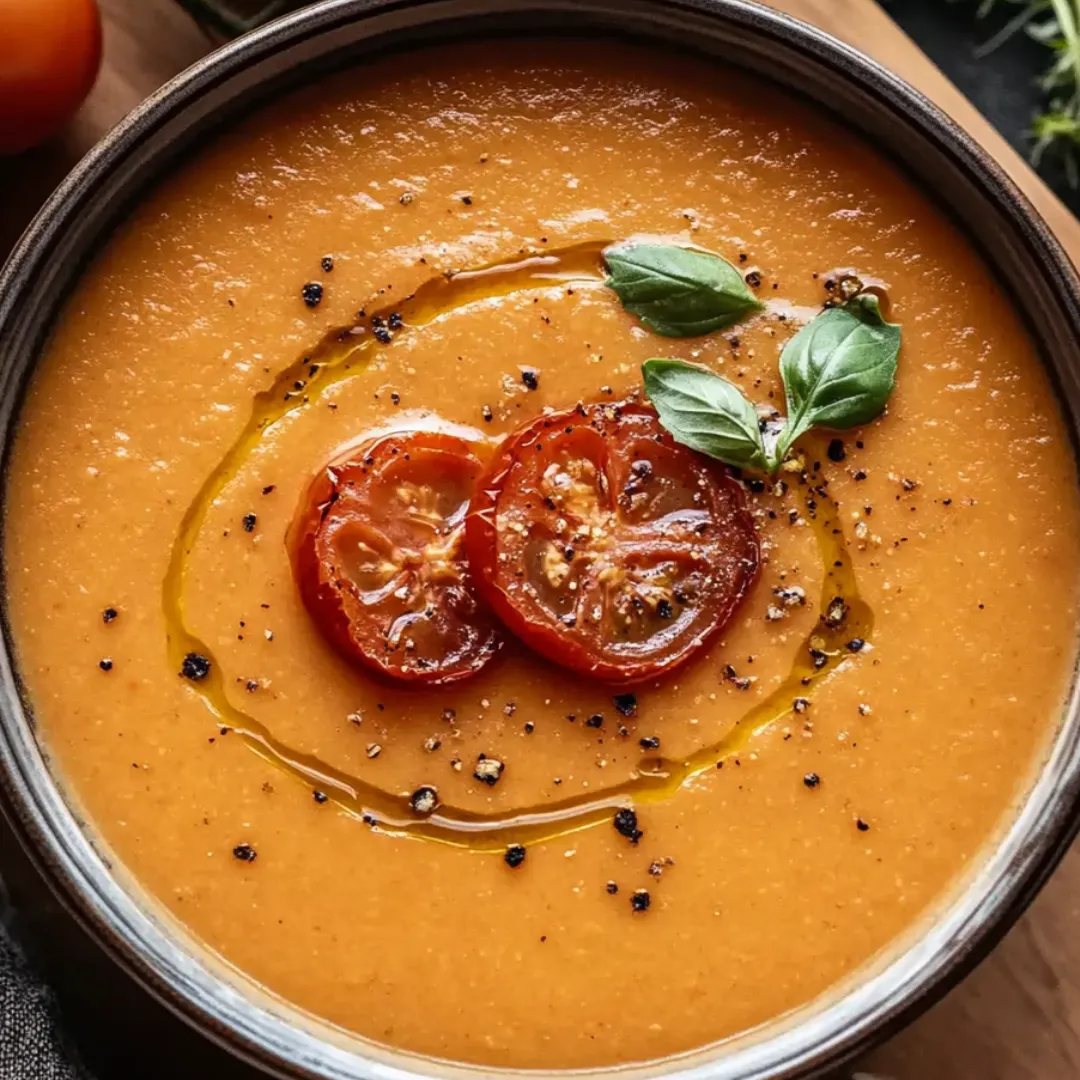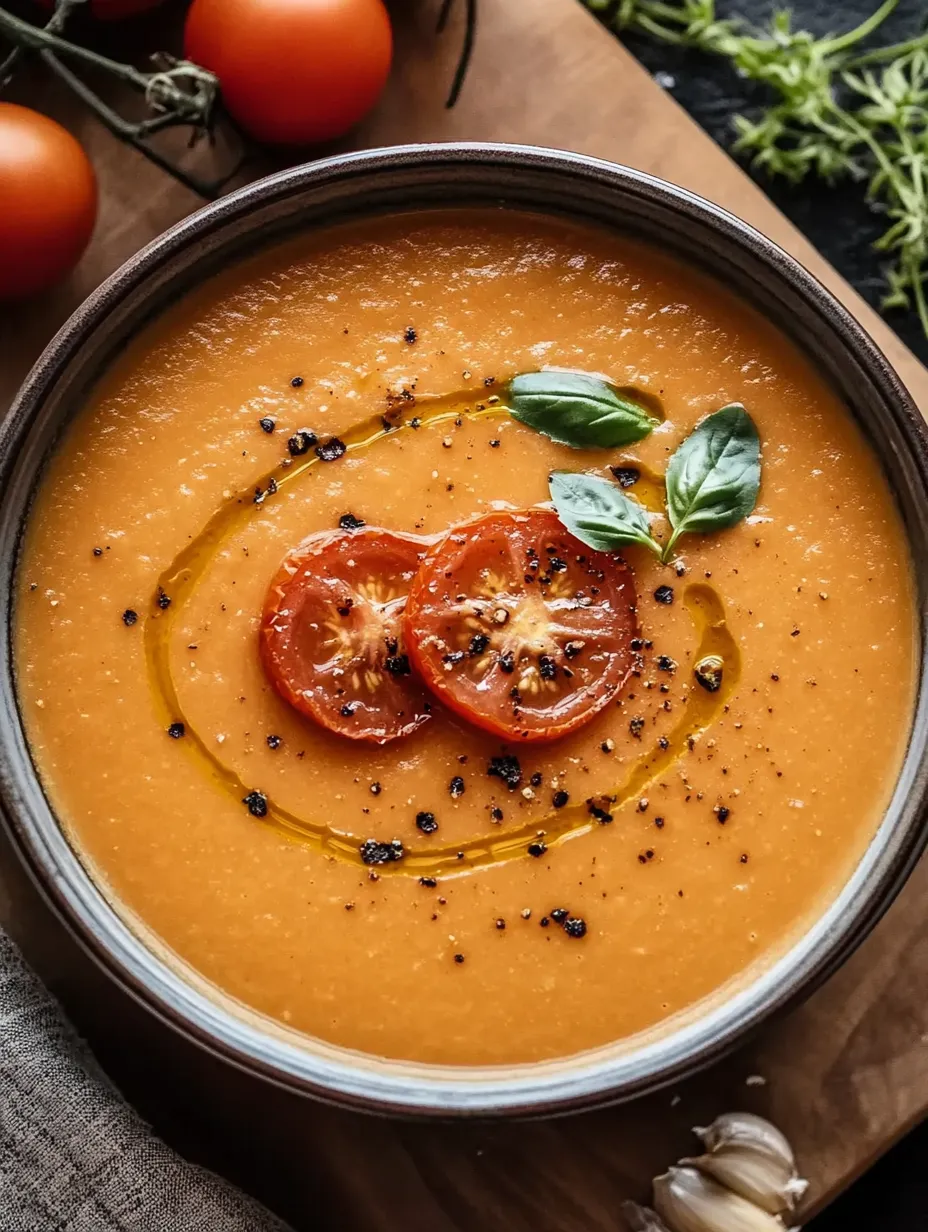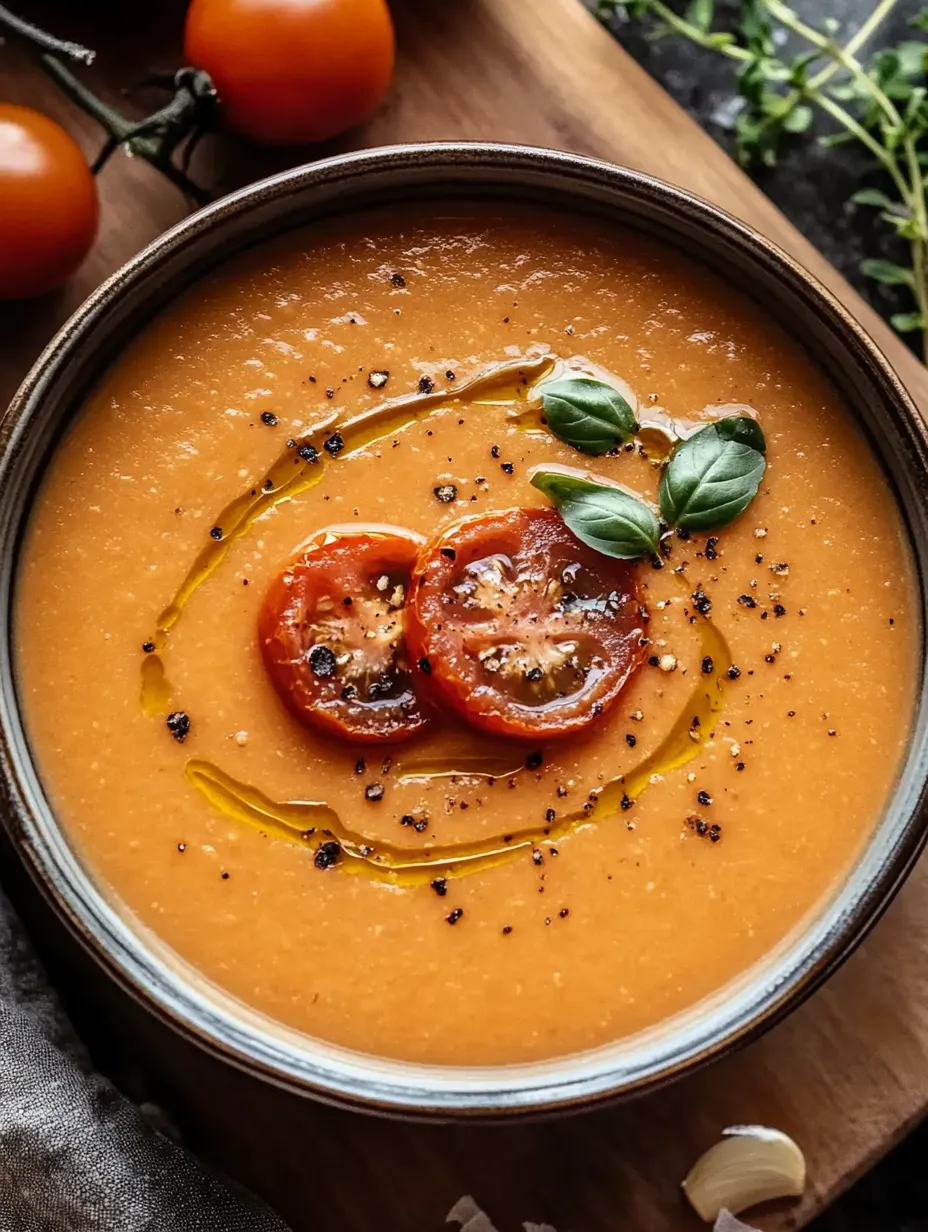 Pin it
Pin it
This velvety Creamy Roasted Garlic Tomato Soup transforms humble ingredients into a restaurant-quality dish that's both comforting and sophisticated. The magic happens when ripe tomatoes and whole garlic bulbs slowly caramelize in the oven, developing deep, complex flavors that no canned soup can match. Each spoonful delivers a perfect balance of natural tomato sweetness and mellow, buttery garlic, enriched with a silky cream finish and aromatic herbs. The roasting process intensifies the tomato flavor while mellowing their acidity, creating a soup with remarkable depth that tastes like it simmered all day, even though it requires minimal hands-on time. Whether paired with a grilled cheese sandwich for casual comfort or served as a refined first course for dinner guests, this soup elevates the classic tomato experience into something truly memorable.
I first developed this soup recipe on a rainy autumn afternoon when I was craving something warm and comforting but wanted to elevate the experience beyond opening a can. What began as a simple experiment became an absolute revelation—the flavor complexity from roasting the ingredients created something that tasted like it came from a high-end restaurant rather than my own kitchen. What surprised me most was my husband's reaction; he's never been a tomato soup enthusiast, yet found himself reaching for a second bowl, then using bread to capture every last drop. What I appreciate most about this recipe is how it transforms everyday ingredients through a simple technique that doesn't require culinary training. This soup has become our standard for cold evenings, sick days, and anytime we need a meal that feels like a warm embrace.
Ingredients You'll Need
- 2 pounds Fresh Tomatoes (Roma or vine-ripened), halved: The foundation of your soup. Ripe, in-season tomatoes provide the best flavor, but good-quality canned tomatoes work in winter months
- 1 whole Garlic Bulb: Roasting transforms harsh garlic into sweet, mellow goodness. Don't be alarmed by the quantity—it mellows beautifully
- 1 medium Onion, chopped: Creates an aromatic base that adds depth and natural sweetness
- 2 cups Vegetable Broth: Forms the liquid foundation. Homemade provides the best flavor, but quality store-bought works well too
- 1 cup Heavy Cream: Creates the luxurious, velvety texture. For dairy-free options, coconut milk makes an excellent substitute
- 2 tablespoons Olive Oil: Used for roasting and sautéing. Extra virgin adds the most flavor
- 1 teaspoon Salt: Enhances all the flavors. Sea salt or kosher salt is preferable to table salt
- ½ teaspoon Black Pepper: Adds gentle heat and depth. Freshly ground provides the most vibrant flavor
- 1 teaspoon Dried Basil (or 1 tablespoon fresh): Contributes classic Italian herbal notes that complement tomatoes perfectly
- ½ teaspoon Smoked Paprika (optional): Adds a subtle smoky dimension that enhances the roasted flavors
- 1 teaspoon Sugar (optional): Balances acidity if needed. Often unnecessary with properly roasted tomatoes
- 1 tablespoon Tomato Paste: Intensifies the tomato flavor and adds rich color
- 1 tablespoon Balsamic Vinegar (optional): Contributes complexity with its sweet-tart profile
 Pin it
Pin it
Step-by-Step Cooking Instructions
- Prepare for Roasting:
- Begin by preheating your oven to 400°F (200°C). Line a large rimmed baking sheet with parchment paper for easier cleanup. This temperature is perfect for caramelizing the vegetables without burning them. While the oven heats, halve your tomatoes along their equator (rather than through the stem) to expose more flesh for roasting. This cut maximizes the surface area that will caramelize, developing those complex sweet flavors that make this soup special.
- Season and Arrange Tomatoes:
- Place your halved tomatoes on the prepared baking sheet, cut side facing up. Positioning them cut-side up allows the natural juices to concentrate rather than run out onto the pan. Drizzle about one tablespoon of olive oil over the tomatoes, then season with approximately half the salt and pepper. The oil helps conduct heat evenly across the surface of the tomatoes while the salt draws out moisture, concentrating flavor as they roast.
- Prepare the Garlic:
- Take your whole garlic bulb and slice off just the top quarter-inch to expose the individual cloves while keeping the head intact. This technique allows the garlic to roast in its own natural wrapper, steaming the cloves to perfection inside. Place the garlic on a small square of aluminum foil, drizzle with a teaspoon of olive oil, and wrap it loosely but securely. The foil packet creates a mini steam environment that softens the garlic while allowing it to caramelize. Place this packet on the same baking sheet as the tomatoes.
- Roast to Perfection:
- Slide the baking sheet into your preheated oven and roast for 35-40 minutes. You'll know the tomatoes are done when they've collapsed slightly, their edges have begun to caramelize, and their color has deepened significantly. The garlic is ready when you can easily pierce the cloves with a knife—they should be completely soft and golden. This slow roasting process transforms both ingredients, mellowing their sharpness while dramatically enhancing their natural sweetness and complexity.
- Start the Soup Base:
- About 10 minutes before the tomatoes finish roasting, begin preparing your soup base. Heat the remaining tablespoon of olive oil in a large, heavy-bottomed pot over medium heat. Add your chopped onion and sauté for 5-7 minutes until completely soft and translucent but not browned. The onions provide an aromatic foundation for the soup, and proper softening ensures they'll blend smoothly later. Once the onions are soft, add the tomato paste, dried basil, and smoked paprika (if using). Cook for another 1-2 minutes, stirring constantly, to bloom the spices and caramelize the tomato paste slightly, which removes any tinny flavor and deepens the overall tomato profile.
- Combine and Blend:
- Once your tomatoes and garlic have finished roasting and cooled slightly, squeeze the garlic cloves from their papery skins directly into the pot—they should slip out easily. Use a spatula to transfer the roasted tomatoes and all their juices from the baking sheet into the pot as well. Pour in the vegetable broth, add the balsamic vinegar if using, and bring the mixture to a gentle simmer for about 5 minutes to allow the flavors to meld. Using an immersion blender, carefully blend the soup directly in the pot until completely smooth. If you don't have an immersion blender, transfer the mixture in batches to a standard blender, being careful to vent the lid to prevent pressure buildup from the steam.
- Add Creaminess and Final Seasonings:
- Once your soup is completely smooth, reduce the heat to low and stir in the heavy cream. Allow the soup to warm through for about 3-5 minutes, but don't let it come to a boil, which can cause the cream to separate. Taste and adjust the seasonings, adding the remaining salt and pepper as needed. If your tomatoes were particularly acidic, this is the time to add the optional teaspoon of sugar to balance the flavors. The perfect soup should have a harmonious balance of sweet, savory, and tangy notes, with no single flavor dominating.
- Rest and Serve:
- Although it's tempting to serve immediately, allow the soup to rest off the heat for about 5 minutes. This brief resting period allows the flavors to settle and marry, resulting in a more cohesive and nuanced taste experience. Ladle the soup into warmed bowls and finish with a swirl of cream, a drizzle of extra virgin olive oil, or a sprinkle of fresh herbs if desired. These final touches not only enhance the flavor but also create a beautiful presentation that elevates this homemade soup to restaurant quality.
Perfect Pairings
While delicious on its own, this soup reaches its full potential when thoughtfully paired. For the classic comfort combination, serve with a perfectly golden grilled cheese sandwich made with good sharp cheddar and sourdough bread—the tangy cheese and crispy buttery exterior create a perfect textural contrast to the smooth soup. For a more sophisticated presentation, top the soup with herbed croutons, a small dollop of pesto, and a few shavings of aged Parmesan. Wine lovers will appreciate how this soup pairs beautifully with a medium-bodied red like Sangiovese or a crisp, unoaked Chardonnay that complements the tomatoes' natural acidity.
Creative Variations
The basic recipe welcomes numerous adaptations to suit your taste or pantry. For a Tuscan twist, add a can of drained white beans during the blending stage for extra protein and creaminess without additional dairy. Spice enthusiasts might appreciate a roasted red pepper version—simply add two roasted, peeled bell peppers to the tomatoes before blending. For a sophisticated flavor profile, stir in 2 tablespoons of cognac or sherry just before adding the cream. Garden-fresh summer soups can be enhanced with a handful of fresh basil leaves blended in at the end, while winter versions might benefit from a teaspoon of thyme and a pinch of nutmeg for warmth.
Make-Ahead Options
This soup is perfect for meal preparation as the flavors actually improve with time. Make it up to three days ahead and store in the refrigerator—the flavor will deepen as it sits. When reheating, do so gently over medium-low heat to prevent the cream from separating. For longer storage, freeze the soup before adding the cream, then thaw completely and add fresh cream while reheating. Portion into individual containers for easy grab-and-go lunches that can be reheated in the microwave, though stovetop reheating is preferable for maintaining the best texture.
Nutrition Boost
While already packed with antioxidants from the tomatoes, you can enhance the nutritional profile of this soup in several ways. Add a handful of baby spinach just before blending for a vitamin boost that won't change the flavor significantly. For additional fiber and nutrients, blend in a roasted sweet potato or carrot. Using bone broth instead of vegetable broth increases the protein content while adding additional minerals. For those watching calories, light coconut milk or half-and-half can replace the heavy cream with minimal impact on the luxurious texture.
 Pin it
Pin it
Chef's Helpful Tips
- Temperature Management - Never boil the soup after adding cream; gentle heating preserves the silky texture
- Seasoning Strategy - Salt the tomatoes before roasting but adjust final seasonings after cream is added
- Storage Secret - Place plastic wrap directly on the surface of leftover soup before refrigerating to prevent skin formation
My first attempt at this soup taught me the transformative power of roasting. I had always made tomato soup on the stovetop, but the depth of flavor from oven-roasting was a complete revelation—it eliminated the tinny taste that often plagues tomato soups while creating natural sweetness that balanced the acidity perfectly. Another game-changer was learning to add the balsamic vinegar, which creates a complex umami backbone that makes people wonder what your secret ingredient is. My favorite memory with this recipe was serving it on a snowy evening when neighbors unexpectedly dropped by. With just some crusty bread and a simple salad, this soup became the centerpiece of a warm, impromptu gathering that stretched into the night. The greatest compliment came from a friend who claimed to dislike tomato soup—he not only finished his bowl but asked for the recipe before leaving.
I've made countless versions of tomato soup over the years, but this roasted garlic version has become my signature recipe—the one friends request by name and family members have come to expect on special occasions. What I find most rewarding about this recipe is how it transforms humble, accessible ingredients into something that tastes truly special through a simple technique that anyone can master. The roasting process might take a bit more time than opening a can or simmering raw ingredients, but the flavor payoff is immeasurable. There's something deeply satisfying about serving a soup that looks deceptively simple yet delivers complex flavor in every spoonful. Whether you're cooking for yourself, your family, or guests, this soup carries that magical quality of feeling both like a comforting hug and an elegant indulgence simultaneously.
Frequently Asked Questions
- → Can I use canned tomatoes instead of fresh?
- Yes, you can substitute about 28 ounces (800g) of canned whole tomatoes, drained. You'll miss some of the caramelized flavor from roasting, but you can enhance it by adding a tablespoon of tomato paste and a teaspoon of sugar. Alternatively, you can roast the canned tomatoes for about 20 minutes to develop some of that flavor.
- → How can I make this soup thicker?
- For a thicker consistency, use less broth initially (start with 1½ cups instead of 2). You can also add a tablespoon of flour to the onions before adding liquids, or simmer the soup uncovered for 5-10 minutes longer to reduce it. Another option is to add a small peeled and diced potato when blending, which adds thickness without changing the flavor significantly.
- → Is there a way to make this soup ahead of time?
- This soup actually tastes even better the next day after the flavors have had time to meld. Make it completely, let it cool, and refrigerate for up to 3 days. Reheat gently over medium-low heat. You can also freeze this soup for up to 3 months - just wait to add the cream until after you've thawed and reheated it.
- → How can I make this recipe vegan?
- For a vegan version, use vegetable broth and substitute the heavy cream with full-fat coconut milk or a cashew cream (blend 1 cup of soaked cashews with ½ cup water until smooth). Both alternatives maintain the soup's creamy texture while adding subtle complementary flavors.
- → What herbs can I use to garnish this soup?
- Fresh basil is the classic choice and pairs perfectly with tomato. Other excellent options include fresh thyme, chives, or a light sprinkle of oregano. For added texture and flavor, try topping with homemade croutons, a swirl of pesto, or a dollop of sour cream.
